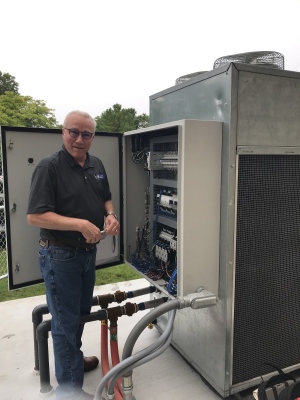by
John W. Mitchell, Senior Correspondent | October 07, 2019

Dan Kehl checks in on a Dimplex Thermal MR chiller.
From the October 2019 issue of HealthCare Business News magazine
Cooling is the life force of any MR unit. Yet this vital function is often treated as an afterthought, setting up expensive consequences. An MR’s cooling platform consists of three components: chiller, cold head, and compressor. All are equally vital in regulating the chill water and helium that moves heat away from an MR magnet.
MR cooling problems tend to be seasonal. Kim Elmore, operations and business development manager for KR Products, which specializes in building refrigeration equipment, said the toll of delayed preventive maintenance emerges with the spring season. Every year between April and September, she fields a couple of phone calls a week concerning faulty MR chillers.
"When I ask them what the glycol percentage [to water] is, I often find they don’t know what I’m talking about,” said Elmore. “I even find that in some cases, the caller tells me that they refill their reservoirs with straight water.”



Ad Statistics
Times Displayed: 137108
Times Visited: 7945 MIT labs, experts in Multi-Vendor component level repair of: MRI Coils, RF amplifiers, Gradient Amplifiers Contrast Media Injectors. System repairs, sub-assembly repairs, component level repairs, refurbish/calibrate. info@mitlabsusa.com/+1 (305) 470-8013
This despite warning stickers all over the big chiller units and the owner’s manual about the importance of maintaining the proper ratio of glycol to water. Optimal levels are between 30 to 50 percent glycol, depending upon the latitude of a location. As with the antifreeze in a car, Elmore said colder temperatures call for higher glycol levels in a chiller.
Sumitomo producing more than 2,500 cold heads a year with a warranty return rate of less than 0.5 percent. Photo courtesy of Sumitomo Cryogenics of America
"If it gets below 30 percent, the inhibitor won't work and encourages bacteria and algae in the fluid,” said Dan Kehl, service technician at Dimplex Thermal, a chiller and cooling systems provider. “If that happens, the heat exchangers can become fouled … and it will require two days of downtime to clean the entire fluid system."
To avoid this, Kehl recommends two preventive maintenance checkups per year, one in the spring and one in the fall, to thoroughly inspect the fluids and take refrigeration readings, as well as clean the unit.
“Part of the problem is these big chiller units are often up on the roof, out of sight. No one thinks about them until something starts to go wrong,” said Elmore. “Without the proper glycol level, the heat exchanger will burst, resulting in a compressor failure.”

